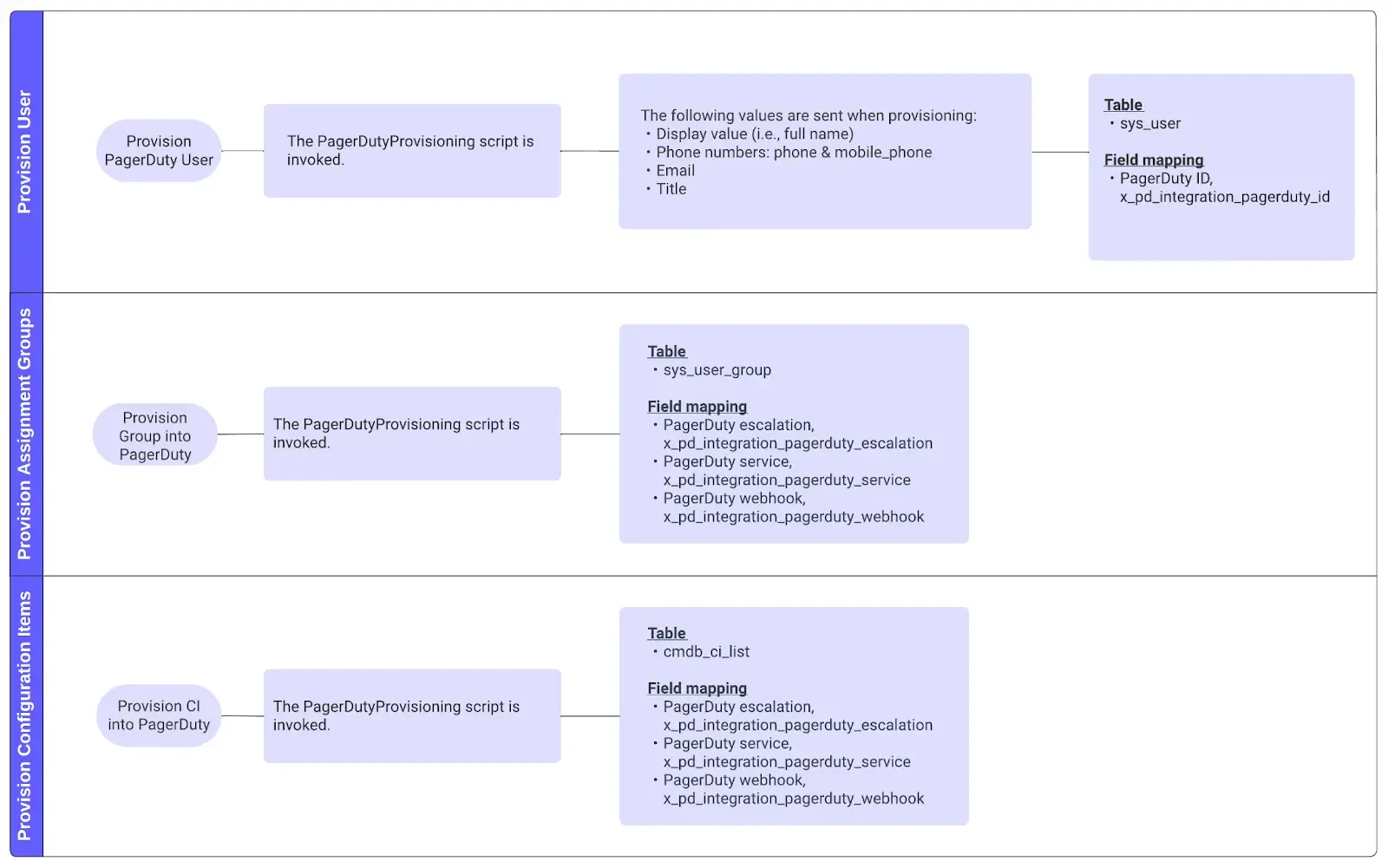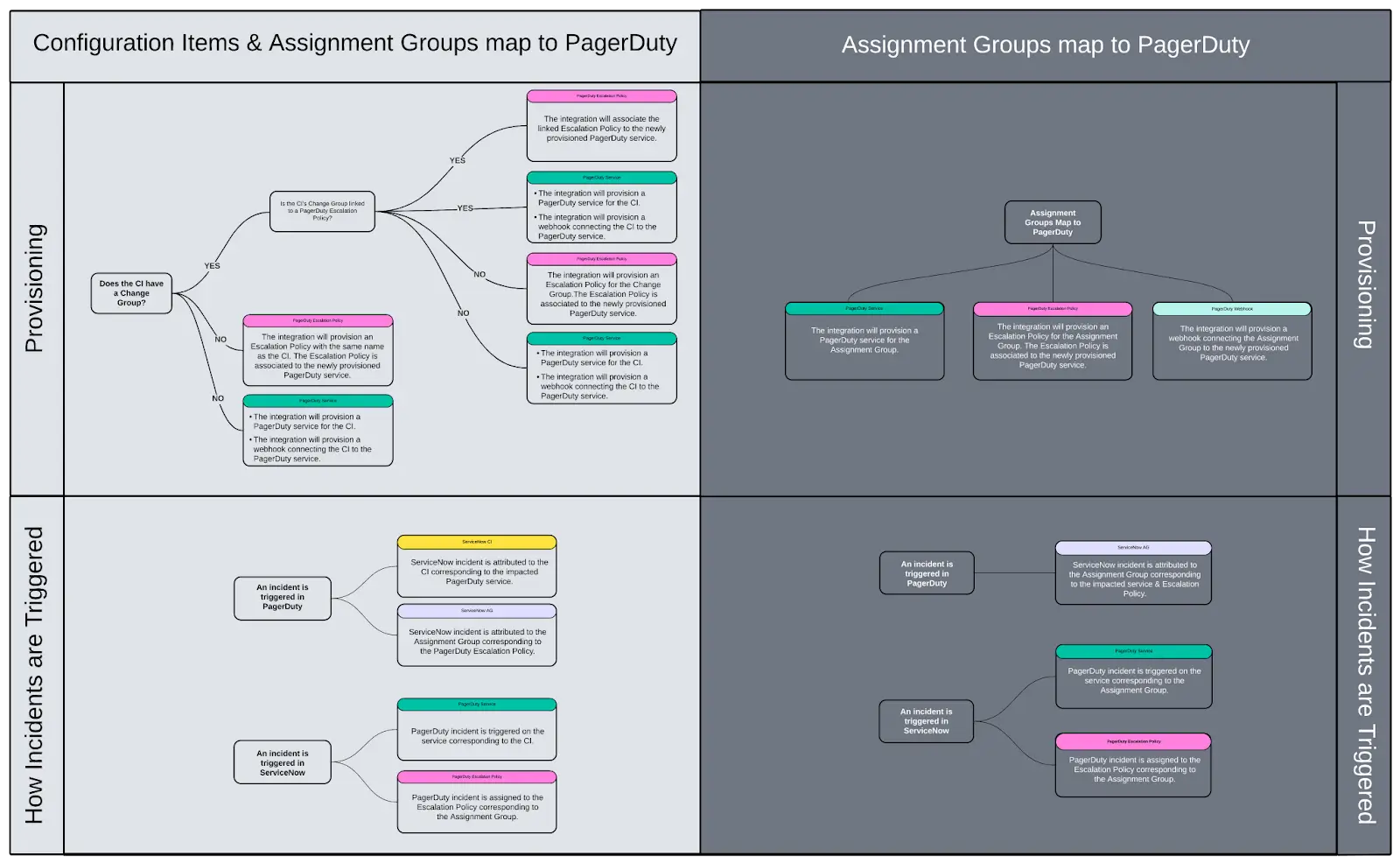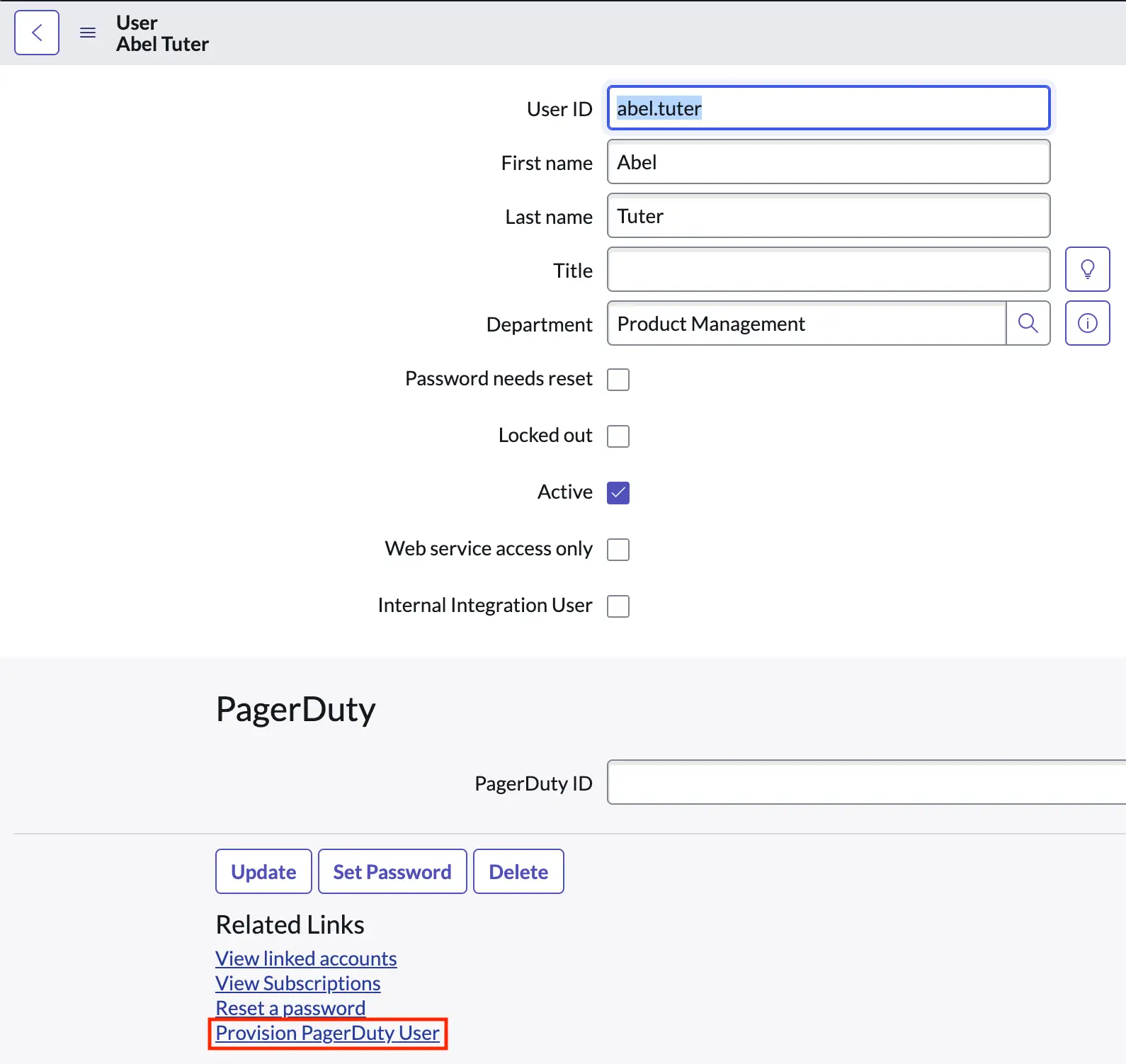ServiceNow Provisioning
Provision ServiceNow objects to PagerDuty
Provisioned versus Linked
Provisioned
The term provisioned describes the process by which the integration generates a new object (or objects) in PagerDuty, corresponding to an object in ServiceNow. Following this, the integration will update the integration fields within the ServiceNow record to display the ID(s) of the newly created objects in PagerDuty.
Linked
The term linked describes the process by which the integration associates and connects existing PagerDuty resources to existing ServiceNow resources.
Link PagerDuty Escalation Policies to ServiceNow Assignment Groups
You can link existing PagerDuty Escalation Policies to ServiceNow Assignment Groups:
- In PagerDuty, navigate to the Escalation Policy you want to link.
- Copy the escalation policy's ID from the URL, e.g.,
PXXXXXX. - In ServiceNow, navigate to the Assignment Group record.
- Paste the copied Escalation Policy ID into the
PagerDuty default escalationfield, then save the record.
Link PagerDuty Services and Webhooks to ServiceNow
You can link existing PagerDuty services to ServiceNow Assignment Groups and Configuration Items:
- In PagerDuty, navigate to the service you want to link
- Copy the ID of the PagerDuty service from the URL
- In ServiceNow, navigate to the Assignment Group or Configuration Item record
- Paste the copied service ID into the
PagerDuty servicefield, then save the record
After saving, a Provision Webhook into PagerDuty link will appear in the Related Links section of the record. Clicking this link creates a new v3 webhook subscription in PagerDuty. The integration will then update the PagerDuty webhook field in the record to display the ID of the newly created webhook subscription.
How ServiceNow Objects are Provisioned into PagerDuty
Required User Permissions
The ServiceNow
x_pd_integration.adminrole is required to provision services and users to PagerDuty.
For any ServiceNow User, Assignment Group, or Configuration Item (CI) to be recognized by the integration, it must be provisioned.
Objects can be provisioned by navigating to the Related Links section in the User, Assignment Group, or Configuration Item form and clicking Provision PagerDuty User, Provision Group into PagerDuty or Provision CI into PagerDuty. This process will make the necessary REST API calls in the PagerDutyProvisioning script.

How ServiceNow Objects Map to PagerDuty Objects
The Choose ServiceNow to PagerDuty mapping setting allows the following two mapping options:
- ServiceNow Configuration Items and Assignment Groups map to PagerDuty (Recommended)
- Assignment Groups map to PagerDuty
The diagram below represents the correspondence between ServiceNow and PagerDuty.

Provision Users to PagerDuty
- In your ServiceNow Users list, select a user who has not already been provisioned to PagerDuty.
- Click Provision PagerDuty User to add them to your PagerDuty account.
- You will then see a message that the user is being provisioned.
- Upon completion, the PagerDuty ID field is automatically populated. The user also shows up in PagerDuty, with the same name and email address.
- If the user has their Phone or Mobile phone fields populated in ServiceNow, these settings will also be automatically provisioned as Contact Methods and Notification Rules in PagerDuty.
- A country code is required for phone numbers.
- The country code may not parse correctly if the phone number is not in the E.164 format.
- You can also provision multiple users at once by selecting the checkboxes to the left of their names, clicking Actions on selected rows and selecting Provision PagerDuty User from the dropdown.
- If the user has their Phone or Mobile phone fields populated in ServiceNow, these settings will also be automatically provisioned as Contact Methods and Notification Rules in PagerDuty.
Example

Provisioning a single user

Provisioning multiple users
Provision Assignment Groups and Configuration Items
New Assignment Groups and Configuration Items provisioned to PagerDuty will be connected via v3 webhooks. We strongly recommend that you migrate webhooks to v3 immediately after upgrading to ServiceNow v8, to prevent the application from having a mix of v2 and v3 webhooks.
Prerequisite: Set Default Incident Sync Option
Before provisioning Assignment Groups or Configuration Items to PagerDuty, you can set the default incident sync option in PagerDuty Settings. This setting only applies to how PagerDuty incidents creates ServiceNow incidents. Assignment Groups and Configuration Items that do not have an individual sync option configured will default to the sync option set on the PagerDuty Settings page.
- Navigate to PagerDuty Settings and scroll to the Webhooks Configuration section.
- You may select the incident sync option from the Sync option dropdown:
- Auto: When a PagerDuty incident triggers, it automatically creates a ServiceNow Incident.
- Manual: When a PagerDuty incident triggers, it will not automatically create a ServiceNow Incident. Instead, you will need to select More Sync with ServiceNow on the PagerDuty incident’s details page.
Provision Individual Configuration Items to PagerDuty
-
In ServiceNow, navigate to
cmdb_ci_list.doclick on the Configuration Item that you want to provision to PagerDuty. -
Click Provision CI into PagerDuty.
Bulk Provision Configuration Items to PagerDuty
- In ServiceNow, navigate to
cmdb_ci_list.doselect the checkboxes to the left of the Configuration Items that you want to provision to PagerDuty. - Click the Actions menu on the top right and select Provision CI Into PagerDuty.
Provision Individual Assignment Groups to PagerDuty
- In ServiceNow, navigate to
sys_user_group_list.doclick on the Assignment Group that should be provisioned to PagerDuty. - Click Provision Group into PagerDuty.
Bulk Provision Assignment Groups to PagerDuty
- In ServiceNow, navigate to
sys_user_group_list.doselect the checkboxes to the left of the Assignment Groups that you want to provision to PagerDuty. - Click the Actions menu on the top right and select Provision Groups Into PagerDuty.
Edit Webhooks Configuration
When you provision a webhook, it will inherit the default sync behavior configured on the PagerDuty Settings page in ServiceNow (PagerDuty Settings Webhook Configuration Sync option). However, you can modify the sync option for your webhooks as necessary:
- Navigate to PagerDuty Webhooks.
- Select the checkboxes to the left of the webhooks that you want to modify.
- Click the icon to the right of the sync option column, and select Update Selected.
- If you do not see this column, add Sync option to the Selected fields.
- Select your preferred Sync option, and then click Update.
Provision Configuration Items to PagerDuty with Services Provisioning
The Services Provisioning feature allows you to provision Configuration Items as Business Services and technical services in PagerDuty, along with their dependencies. You can quickly generate a new PagerDuty service and webhook connection for Configuration Items in ServiceNow. Any Configuration Item that extends the base cmdb_ci table can be mapped to PagerDuty.
This feature is located in ServiceNow under PagerDuty Services Provisioning.
Tips
Before provisioning Configuration Items as services in PagerDuty, we recommend the following:
- Read our Full Service Ownership Guide for best practices in planning your PagerDuty technical and business service relationships.
- Given the dependency relationships between business and technical services, review how you would like to map Configuration Item relationships, noting the higher-level CMDB classes and lower-level CMDB classes.
Provisioning Behavior
The parent CI(s) will be provisioned as a business service in PagerDuty. Child CIs (downstream dependencies) will be provisioned as supporting technical services in PagerDuty.
CI Contains a Change Group
If the CI's Change Group already exists as a PagerDuty escalation policy, the integration will attach the existing escalation policy to the newly created PagerDuty technical service. Otherwise, the integration will provision a new escalation policy for the Change Group, and attach the escalation policy to the newly created PagerDuty technical service.
CI does not Contain a Change Group
The integration will create a PagerDuty escalation policy with the same name as the CI and attach it to the newly created PagerDuty technical service.
Step 1: Choose Provisioning Method
Best Practices
If you have a well-established CMDB, we recommend that you provision using the CMDB relationship table. A well-established CMDB has a defined relationship between parent CIs and their associated downstream dependencies.
If you do not have a defined relationship between the parent CIs and their downstream dependencies (child CIs), you can provision business services and technical services using custom relationships.
Option 1: Provision Services using a CMDB Relationship Table
- In ServiceNow, navigate to PagerDuty Services Provisioning.
- In the field Provision using CMDB relationship table, select Yes (default) from the dropdown.
- Choose CI classes to be provisioned. If the parent CI(s) have a business service classification (e.g., CI Class is Business Service), and the downstream CIs have a technical service classification (e.g., CI Class is Technical Service), select the checkbox Use service classification where applicable.
Tip
If a CI Class is both a business service and a technical service, then the CI will be provisioned as both a business and technical service, with the business service having a dependency on the technical service.
Other CI classes will need to manually classified as a business service or technical service, following the process below:
- Click Select CI Classes which will be provisioned as Business Service, select your desired CI Class from the list, and click to move the CI into the column Business Services.
- Click Select CI Classes which will be provisioned as Technical Service, select your desired CI Class from the list, and click to move the CI into the column Technical Services.
-
Choose Table with CIs or a single CI to be provisioned along with dependencies.
Option A: Choose Table with CIs
You can use this option if:
- You want to provision multiple parent CIs as a business service, and their downstream dependencies as technical services.
- There is a single CI table containing those parent CIs.
- For the field Select table containing services, click the search icon.
- A pop-up window will appear on your screen. In the pop-up window, search and select the CI table containing the parent CIs that you want to provision as PagerDuty business services. This will retrieve all of the CIs from the selected CI table, along with their dependencies. For example, selecting
cmdb_ci_datacenterwill fetch all of the CIs in the data center table along with its dependencies. - After the CIs have been fetched, you can create a filter to exclude the CIs that you do not want to provision as business services in PagerDuty. Click Open selected table to set and save filter.
- Filter out the CIs that you do not want to provision as business services in PagerDuty. Save this filter for use in future steps.
- For the field Select filter, click the search icon.
- A pop-up window will appear. In the pop-up window, find and select the filter you created in step 4 above.
- Select Column for Service Name: select the table column which will define the service name in PagerDuty. The Name column is set by default, but you may change it to a different column if required.
- Click Save Configuration.
Option B: Choose a Single CI
Alternatively, you can use this option if:
- There is only one parent CI that you want to provision as a business service in PagerDuty.
- The parent CI contains downstream dependencies that you want to provision as technical services in PagerDuty.
- Select the checkbox next to Provisioning a single CI along with its dependencies.
- Find and select your CI, then click Save Configuration.
Option 2: Provision Using Custom Relationships
Tip
If you do not have a defined relationship between the parent CIs and their downstream dependencies (child CIs), you can use this method to define the service relationship you want to provision in PagerDuty.
- In ServiceNow, Navigate to PagerDuty Services Provisioning.
- In the field Provision using CMDB relationship table, select No (Custom Relationships) from the dropdown.
- For field Select CI Table containing services, click the search button.
- In the pop-up window that appears, find and select the table containing the parent CIs that you want to provision as a business service. This will retrieve all of the CIs from the selected CI table, along with their dependencies.
- Click Open selected table to set and save filter. In the pop-up window that appears, create a filter to exclude all of the other CIs that you do not want to provision as business services in PagerDuty. Save this filter for use in the next step.
- For the field Select filter, click the search icon. In the pop-up window that appears, find and select the filter you created in the previous step.
- Configure the following fields:
| Field | Instructions |
|---|---|
| Select the type of service to be provisioned | Select Business Service. |
| Select column for service name | Select the table column which will define the service's name in PagerDuty. The Name column is set by default, though you may change it to another column if required. |
| Select relationship between services to be provisioned | Select consumes. |
| Select CI table containing services | Select the CI table containing the child CIs (downstream dependencies) that you want to provision as technical services in PagerDuty. |
- Create a filter and apply it to the Child CIs table.
- Click Open selected table to set and save filter.
- In the pop-up window that appears, create a filter to exclude the Child CIs that you do not want to provision as technical services in PagerDuty.
- Save the filter for use in the next step.
- Select the filter you created in the previous step.
- Below your filter in the field Select the type of service to be provisioned, select Technical Service.
- Click Save Configuration.
Step 2: View Services
Navigate to the PagerDuty Service Provisionings table (PagerDuty Services Provisioning Table) to review the parent CI(s) and downstream dependencies that will be provisioned to PagerDuty.
Carefully review the table information before provisioning services.
Review the information in the table:
- Check the Validation warnings column for errors.
- Update the parent type on any records that do not show the correct type for the parent CI.
- Change the child type on any records that do not show the correct type for the child CI.
- Delete any parent CIs and/or dependencies that you do not want to provision into PagerDuty.
- Delete any obsolete or invalid rows that are not provisioned (e.g., Relationship provisioned =
False).
Step 3: Provision Services
After reviewing the Services Provisioning table, click Provision Services.
If there are any errors while provisioning, they will be captured in the Provisioning errors column of the Services Provisioning table (x_pd_integration_pagerduty_service_provisioning_list.do). Fix any errors, then click Revalidate Services to confirm that the errors have been resolved. Then click Provision Services again.
Updated 3 months ago
